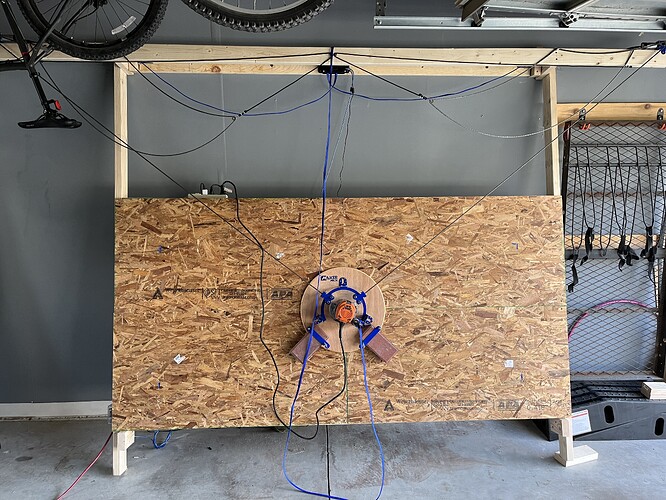Hi all,
I’m new to Maslow CNC, and elected to go big with my frame in a fairly small space for the machine, and jumped straight to a 12 ft Top bar for my frame. Having barely a two-car garage and parking two vehicles in that garage, which is also packed with the various other things, I elected to wall-mount my frame instead of giving it a free floating frame and built it so it can stow vertically or deploy to the recommended angle for use. This all went fairly well and allows the machine to fit.
I purchased the kit from Maker Made including the Z motor and sled but didn’t spring for the upgraded version… at least not yet. I’m running the standard router. Controlling this via a Pi, I have skipped GroundControl entirely, and moved to WebControl. It took a few days, but I am able to get UP, DOWN, LEFT, RIGHT and Z movement. I’ve found center/home and have validated all of the parts are working.
I’m having an issue with calibration. I have a 1219.2mm spoil height, and a 2438.4 spoil width (4FTx8FT workspace). My motor width is 3552.825mm (12 ft top bar). My motor height is 832.2mm. I am feeding chains from the bottom.
I’m somewhat confused by the directions in the calibration process. I assume “setting zero” is just that, placing a single tooth on each motor straight up, and placing chain onto the motor so that the sled is centered, and manually setting home position, based on validating visually that the sled is in the right place. I don’t understand all of the “first link on chain” and feed “extend chains” nonsense I’m seeing as part of this process… why or what is that supposed to accomplish? Is it doing some mystical magic I’m not picking up on? If so, it may be feeding into my problem… which… I know this is a long way getting to my issue.
When I run the triangular calibration, it starts with motion lowering the sled several inches immediately, and after traversing left, it seems that the top/left cut is several inches lower than it should be, and if I let it continue, the lower cuts will drop my sled all the way off the spoil board… out of the work zone. I don’t understand why this is the case, because zero (X 0, Y 0) should be 609.6mm from the top of the spoil board and 1219mm from the left of the spoil board. If zeroed, I can’t understand why the initial downward movement occurs at all…
Someone send me a lifeline. Thanks in advance.

